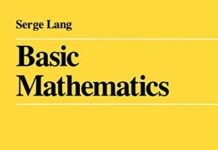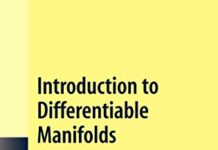
Ebook Info
- Published: 1987
- Number of pages: 631 pages
- Format: PDF
- File Size: 11.51 MB
- Authors: Serge Lang
Description
This new, revised edition covers all of the basic topics in calculus of several variables, including vectors, curves, functions of several variables, gradient, tangent plane, maxima and minima, potential functions, curve integrals, Green’s theorem, multiple integrals, surface integrals, Stokes’ theorem, and the inverse mapping theorem and its consequences. It includes many completely worked-out problems.
User’s Reviews
Reviews from Amazon users which were colected at the time this book was published on the website:
⭐Let me start by saying I will be the first to slam a math text if it’s lacking in clarity, examples, or it’s just ridiculously terse for it’s audience. I’m particularly touchy about books that do not provide enough examples and do not provide solutions in the back (which I think is pedagogically asinine). Also, keep in mind that I’ve seen this material before, but it’s been many years since I’ve thought much about it.That said, I was very pleasantly surprised by this book. I had been lead to believe over the years that all Lang’s books were for students who bordered on genius. Not the case here. Lang certainly doesn’t pat you on the head and say ‘atta boy every five lines, but the exposition is very clear, to the point, and sharp. This text explains the concepts surprisingly well and even though some theorems/concepts here are a bit “terse” (and really they have to be at times when getting up to this level of math) in spots, they are still explained remarkably well.The examples are all relevant and for the most part, Lang does not go off on a tangent with too many applications from physics, economics, stats, etc. This remains essentially a true math book and he only gives applications that are relevant to the topics and techniques from a mathematics point of view–mostly to give more practice with techniques.The exercises tend to be well-graded and he does give good hints when he thinks the difficulty level warrants it. I appreciated that. And, thank god for a change, pretty much ALL the solutions are in the back. I think people who claim that answers should not be in the back of math books are pedagogically off-base. A math student at any level, in my opinion, will benefit from having immediate feedback as to whether he/she is on target or off in left field reinforcing bad habits and faulty techniques. Anyone with any sense of maturity is not going to run to the back of the book and copy answers. That’s absurd. Grade or high schoolers maybe, but the audience is not two-year-olds here. You can think just as long and hard about a problem and finally get it whether the answer is in the back or not. You simply don’t turn to the back until you have your answer (Wow! Who’da thought!). The difference is, with the answer in the back, you get immediate affirmation that your work has paid off or that you need to go back to the drawing board. I can spend 10 hours on a problem regardless of whether the answer’s in the back, but I’ll tell you, after I’ve spent that long getting it, I feel like I’m being patronized if I’m denied the opportunity to confirm my work’s legitimacy.Anyway, enough of that. I also appreciate that Lang’s book is not of the cheesy flavor most texts are today, with gaudy colors, graphics, photos, and tacky little quotes to try and entertain–a math book is not meant to entertain. Anyone at this level better be entertained by the math itself or pick another field. The book has explanation when needed, none when not needed. It has graphics when needed, none when not needed. It has extra explanation of theorem/proof when needed, no extra when not needed. It has a nearly perfect balance of tight, concise presentation and less formal, more generous presentation. At least in my way of seeing it.Overall, very well done. I already have a bunch of other Lang books on my wish list. I’m sure most are much more terse, but I do like Lang’s style of presentation. I also have his “First Course in Calculus.” It’s just as well done. But, as with this text, I don’t think it will appeal to the crowd that thinks being entertained with trivialities is priority. Personally, I appreciate the focus on the mathematics rather than Beatles’ songs or Shakespeare. Not that I don’t appreciate that too, but I can get it elsewhere in more appropriate discourse.
⭐Serge Lang’s Calculus of Several Variables provides an effective introduction to readers with a solid understanding of single variable calculus, such as that gained by working through his
⭐. Like that text, this one clearly conveys the key concepts, places them in context, gives the reader a sense of how mathematicians think about the subject, and teaches the reader the skills needed to solve challenging problems. Methods of solution are clearly explained, then effectively demonstrated through the examples. The exercises, which are generally challenging and occasionally daunting, reinforce these concepts and skills. Answers to most of the problems, including many fully worked out solutions, are provided in a 107 page appendix, making this text suitable for self-study. While Lang’s text is not as rigorous as Tom M. Apostol’s
⭐, many results are proved, others are proved in special cases, and still others are justified through intuitive arguments.The first part of the text, which covers vector functions, is a prerequisite for the remaining parts of the book. It begins with vectors, including the dot (scalar) product, norm, parametric lines, planes, and the cross product. From there, Lang proceeds to differentiation of vectors, functions of several variables (scalar fields), partial differentiation, the gradient, and the Chain Rule. It is an expanded version of the corresponding chapters in his A First Course in Calculus.The second part of the text covers maxima, minima, Lagrange multipliers, and Taylor’s Formula for functions of two variables. Lang goes beyond what is covered in standard texts to address problems in which the extrema may occur on the boundary. He also delves into a discussion of quadratic forms and partial differential operators.The third and fourth parts of the book, which can be covered before the second part, address vector fields, potential functions, line integrals (which Lang calls curve integrals in what appears to have been a vain attempt to introduce more accurate terminology), double integrals, integration with respect to polar coordinates, Green’s Theorem, triple integrals, integration with respect to cylindrical and spherical coordinates, the Divergence Theorem, and Stokes’ Theorem. Lang does an effective job of showing you how these topics are related.The final section of the book introduces those aspects of linear algebra which can be applied to the calculus of several variables, including matrix operations, determinants, and linear mappings. These tools are then applied to illustrate the Jacobian and Hessian matrices, differentiability of vector fields, the Inverse Mapping Theorem, the Implicit Function Theorem, determinants as area and volume, dilations, and change of variable formulas in both two and three dimensions. The exercises in this part of the text and the subsequent appendix on scalar products of functions and the computation of Fourier series are particularly challenging.As much as I like this text, I feel compelled to warn you that there are numerous errors, including some in the answer key. As is the case in most mathematics texts, you will have to fill in the details in some of the examples. However, in the section on center of mass, Lang assigned several problems in which you are supposed to find the y-coordinate of the center of mass of a region of the plane bounded below by the function y = f(x) and above by y = g(x) without explaining that you are supposed to integrate y dy from f(x) to g(x), then integrate the result with respect to x, before dividing by the mass. I learned this from Apostol’s text. My remaining caveat is that Lang sometimes makes an assumption at the beginning of a section to simplify the subsequent discussion. That limits the usefulness of this text as a reference since you cannot simply look up the statement of a theorem, without first checking for additional assumptions stated earlier in the section.Caveats aside, a well-prepared student who works through this text will acquire a solid understanding of the key concepts, learn to solve hard problems, and obtain a solid foundation for more advanced courses such as linear algebra and real analysis. It also provides physics students with the skills required to handle problems in undergraduate courses in classical mechanics, quantum mechanics, and electricity and magnetism .Addendum: The statement of problem 23 in section 2 of chapter 13 is incomplete. In reading Lang’s
⭐, I found a complete statement of the problem. In both books, it begins “Let A be a square matrix which is of the form” [an upper triangular matrix is then shown] In this book, the remainder of the statement is missing. In Introduction to Linear Algebra, it reads “The notation means that all elements below the diagonal are equal to 0, and the elements above the diagonal are arbitrary. One may express the property by saying that a_{ij} = 0 if i > j. Such a matrix is called upper triangular. If A, B are upper triangular matrices (of the same size) what can you say about the diagonal elements of AB?”
⭐I haven’t done much reading and learning with this book, yet, because I’m still studying single variable Calculus. I have looked into the book briefly and I am pleased with the material, thus far. The fact that the whole book is about multivariable Calculus is one of the reasons I made the purchase. My school textbook covers Calculus in n-dimensions; I’m just not there, yet. I’m sure this book will be an excellent reference book when I take third semester Calculus and Differential Equations.
⭐Clear, down to earth math presented in a classic way. I wish it had proofs for more theorems it presents (a few of them do not have a proof).
⭐I received a book in horrible condition. There are absent pages.
⭐I used this in my Calc. III class back in college and loved it – it contains worked examples, good figures, and solutions to several problems at the back of the book. The last few chapters (before the introduction to matrix algebra), unfortunately, are not written clearly. Despite this, in my opinion the first 80% of the book is so instructive that the book is ultimately a great investment.
⭐great!
⭐The technical content of the book is excellent, however the quality of the paper is absolutely horrendous. It’s a shame that whenever I try reading this wonderful book, my eyes get itchy and I begin to sneeze. I wonder about the chemical composition of this paper (what type of mineral additives have been included?), and whether it is safe.
⭐I love Lang’s books, I have half a shelf devoted to him but this is the weakest book I have by him by far.Please do not think this is a bad book, it is a great book by any measure just… weak in some areas.I do not recommend this is your only textbook on the subject, I would treat this as supplementary, a source of practice questions and so forth.Why? He doesn’t introduce any alternative notations, now I don’t expect an author to do this usually but with multivariable calculus I expect a least a footnote saying “some may write this with a single integral and with respect to dA” for example.It takes 333 pages to get to Surface Integrals, Then by 370 has gone on a tangent about (simple) matrices, then mappings, and by 419 determinants, why is this here? To build up to the Jacobian on page 434.This is what I mean by slow, it’s a far larger book than it ought to be, note I have still given it 4 stars, I am not saying it is bad, just narrow, and it lacks analysis it uses what I call “A-level logic” when it comes to calculus, which is fine, but when doing a degree you ought to fuse it with Analysis.Having said that I am fortunate (I did ALL MEI Maths modules at A-level, so I had a great intuitive understanding when I got to university) because a lot of it was familiar to me already, perhaps if one is new and has no other books (for example no other source of linear algebra) this is in fact a strength.Regardless it does lack Analysis – I would have loved this book at A-level, truly.Should you be cautious with your money I recommend checking this out at a library before buying, because it is quite shallow, it is not the reference course that Lang usually writes.I would recommend Theodore Shiffrin’s “Multivariable Mathematics” instead, this covers just as much content, but with the formal definitions of things, and with analysis throughout, as well as going beyond in some areas (like touching on manifolds). While Lang does state the formal definitions of some things (like derivatives) they are confined to the first chapter then left untouched.As I mentioned I recommend this as an extra book.I hope this review helps someone, please ask if you have any questions.
⭐good. I can get confidence on any level of Vec. Cal with this book.no need to type more words
⭐Anche se è, ovviamente, scritto in inglese, il libro presenta i vari argomenti in maniera chiara e concisa e risulta di facile comprensione. Sono presenti inoltre numerosi esercizi risolti.
⭐
⭐Il libro è di una chiarezza espositiva notevole. L’ Autore previene i dubbi e le incertezze del lettore spianandogli il sentiero per una corretta comprensione .
⭐
Keywords
Free Download Calculus of Several Variables (Undergraduate Texts in Mathematics) 3rd Edition in PDF format
Calculus of Several Variables (Undergraduate Texts in Mathematics) 3rd Edition PDF Free Download
Download Calculus of Several Variables (Undergraduate Texts in Mathematics) 3rd Edition 1987 PDF Free
Calculus of Several Variables (Undergraduate Texts in Mathematics) 3rd Edition 1987 PDF Free Download
Download Calculus of Several Variables (Undergraduate Texts in Mathematics) 3rd Edition PDF
Free Download Ebook Calculus of Several Variables (Undergraduate Texts in Mathematics) 3rd Edition





